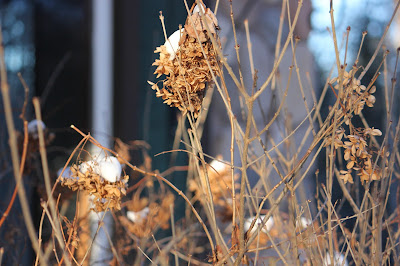Winter interest in the garden takes on special qualities when snow is involved. Snow is a master sculptor and can turn a dingy fall landscape into a brilliant gallery of shape. Choosing the correct plant can add to the splendor and enhance your garden design. Leaves, flowers and grass are my first love, but I can still appreciate the forms that emerge in the snow covered winter landscape.
I have always loved the winter deciduous tree. My dad first taught me how to draw them when I was very little. I would fill notebooks with countless short, tall, skinny, lumpy, rough, winter trees enjoying how striking they appeared on crisp white paper. In the winter landscape, the deciduous tree provides the same striking form and allows the viewer to enjoy its other features like their skeletal shape or the texture of the bark that are less noticeable in full summer foliage.
Hydrangea Paniculata "grandiflora" (PeeGee Hydrangea)
Winter interest in the garden is achieved by providing architectural forms for snow to shape. Plants that hold seed heads or dried flowers like the hydrangea above can offer interest and an open plateau. My favorites:
Hydrangea Arborescens "Anabelle" - Huge erect flower heads perfect for both interior decorating and winter interest. Thrives in the shade.
Hydrangea Paniculata "Limelight" - Excellent lime flower color which dries and holds for long lasting winter interest.
Undisturbed snow mounds over metal.
Larch and rhododendron peak out from their snowy bed. Rhododendron is an evergreen whose leaves will shrivel but hold firm through the winter.
Weeping larch (larix decidua 'pendula') is coniferous, needle and cone bearing, but not an evergreen. It loses its needles in the fall and sprouts fresh and soft in the spring.
Dogwoods, even wild as this native red osier dogwood, are now noticeable without their green foliage. Cultivars make the dogwood a great choice for the home garden. Some of my favorites:
Cornus sericea "flaviramea" - Bright yellow stems offer a fabulous winter effect
Cornus baileyi - Red twigged dogwood with porcelain blue fruit
Fruit trees and bushes that hold their berries can offer show stopping color in the dead of winter. Some of my favorites:
Malus 'Bailears' Ruby Tears (weeping crabapple) - not overly messy, gorgeous weeping
form and long lasting fruit.
Aronia melanocarpa 'Autumn Magic' - beautiful drought tolerant cultivar from University of BC. Covered in late may flowers followed by edible berries which can be eaten fresh, used for baking, jams, and juices, that is if you can beat the birds.
Cotoneaster apiculatus - Cranberry Cotoneaster pink flowers in June followed by bring red fall berries. Although, if you have snow like we do, this low grower will be buried pretty early in the winter season.
Miscanthus sinensis - Zebra Grass
Only the tallest grass varieties have been able to make a showing in my garden this season. Snow long ago blanketed my blue oat grasses and small sedges. In early January a thaw and ice rain crushed weaker stemmed feather reed and panicum grasses and they too are now buried under several feet of snow. Zebra grass has offered the best performance this year in my winter landscape. Zebra grass is from the miscanthus or maiden grass family and is know for its long holding seed heads and sturdy stems which makes it a good pick for adding winter interest. Other big winter impact grasses:
Sorghanstrum nutans - Indian grass
Calamagrostis x acutiflora - Feather reed grass - an excellent grass choice regardless, but it does provide better winter interest in areas that receive less snow.
The wind still blows, the snow still falls, and (for the mean time) it appears winter is here to stay. What plants are brightening your winter landscape? I would love to hear from you!






















































